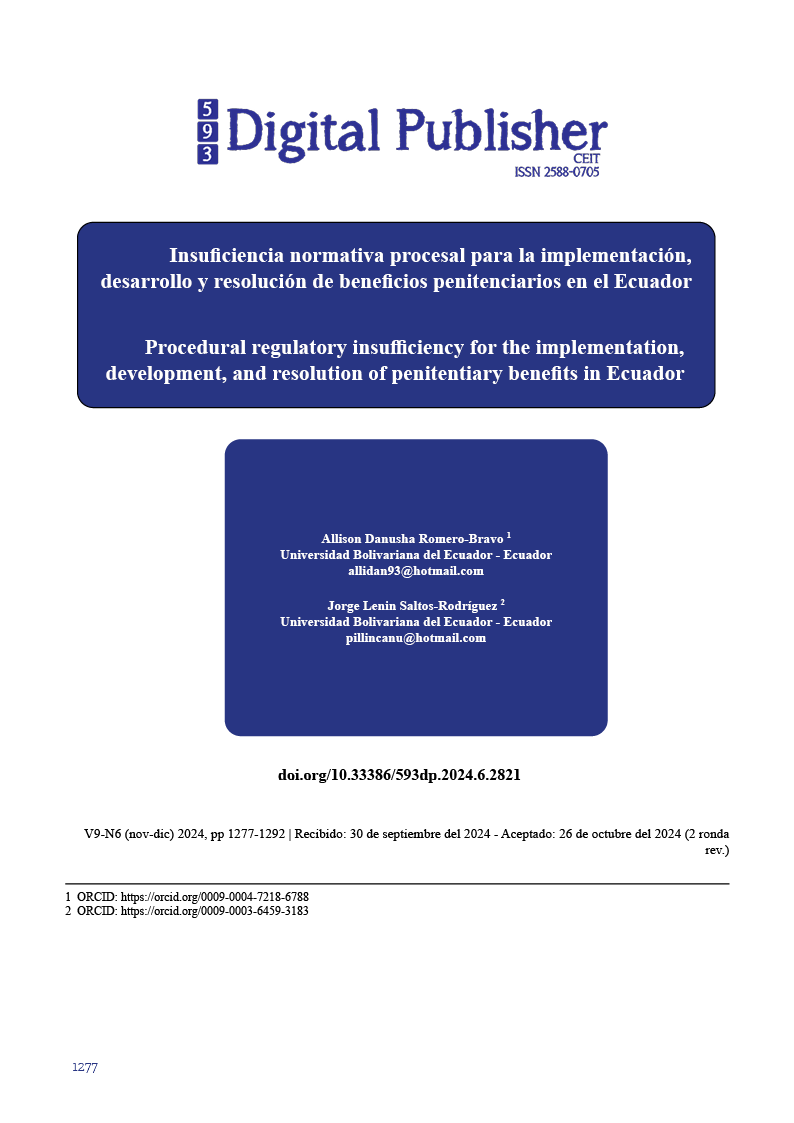Procedural regulatory insufficiency for the implementation, development, and resolution of penitentiary benefits in Ecuador
Main Article Content
Abstract
This article highlights the importance of modifying Article 708 of Ecuador's Comprehensive Organic Penal Code, as well as the implementation of a new article, in relation to the procedural regulatory insufficiency for the implementation, development, and resolution of penitentiary benefits in Ecuador. It emphasizes the necessity and significance of unifying criteria and processes for evaluating rehabilitation activities in different correctional facilities, and establishing specific timelines for the filing and processing of cases for access to changes in the sentencing regime, while safeguarding the rights of the beneficiary. The objective of the research is to determine the impact caused by procedural regulatory deficiencies in this area. A mixed-methods approach was used, with a descriptive-explanatory-propositional scope and a non-experimental, cross-sectional design that included empirical, theoretical, and statistical methods for data processing, along with a comparative legal analysis. These allowed the issue to be addressed from an integral perspective: descriptive (what happens), explanatory (why it happens), and propositional (what can be done). As a result, the article proposes the modification of Article 708 and the inclusion of a new article in the Comprehensive Organic Penal Code to facilitate the implementation and resolution of penitentiary benefits, which was submitted to expert review as validation, with optimal consistency, supporting its feasibility for application.
Downloads
Article Details

This work is licensed under a Creative Commons Attribution-NonCommercial-ShareAlike 4.0 International License.
1. Derechos de autor
Las obras que se publican en 593 Digital Publisher CEIT están sujetas a los siguientes términos:
1.1. 593 Digital Publisher CEIT, conserva los derechos patrimoniales (copyright) de las obras publicadas, favorece y permite la reutilización de las mismas bajo la licencia Licencia Creative Commons 4.0 de Reconocimiento-NoComercial-CompartirIgual 4.0, por lo cual se pueden copiar, usar, difundir, transmitir y exponer públicamente, siempre que:
1.1.a. Se cite la autoría y fuente original de su publicación (revista, editorial, URL).
1.1.b. No se usen para fines comerciales u onerosos.
1.1.c. Se mencione la existencia y especificaciones de esta licencia de uso.
References
Asamblea Nacional del Ecuador. (2008). Constitución de la República del Ecuador. Ciudad Alfaro, Montecristi, Ecuador: Quito, Ecuador : Imprenta del Gobierno.
Relatoría Especial para la Libertad de Expresión. (2016). Informe anual de la Relatoría Especial para la Libertad de Expresión. s.c: Informe anual de la Comisión Interamericana de Derechos Humanos.
Comisión Interamericana de Derechos Humanos. (2022). PERSONAS PRIVADAS DE LIBERTAD. OAS Cataloging-in-Publication Data. Obtenido de El Comité Permanente por la Defensa de los Derechos Humanos.
Comité Permanente por la Defensa de los Derechos Humanos. (2021). REPORTE DE VISITAS DE VERIFICACIÓN DEL CDH POR LA MASACRE EN LA PENITENCIARÍA DEL LITORAL. Guayaquil: Rosa luxemburg stiftung.
Haro-Lara, A. T. (2020). Régimen semiabierto en el sistema penitenciario ecuatoriano. Revista Cientifica y Arbitrada de Ciencias Sociales y Trabajo Social.
Jumbo, J. C. (2011). INSUFICIENCIA NORMATIVA DEL CÓDIGO PENAL PARA JUZGAR A QUIENES UTILIZAN LA EXTORSIÓN DENTRO DE LOS CENTROS PENITENCIARIOS ATENTANDO CONTRA LA VIDA DE LAS PERSONAS PRIVADAS DE LA LIBERTAD. Repositorio digital de la Universidad Nacional de Loja, 23.
Lazo, J. E. (2023). La realidad penitenciaria en el Ecuador,sobrevivencia, descarte social de seres humanos o rehabilitación integral. Revista Foro, 87-105.
Malla, J. P. (2024). El sistema penitenciario ecuatoriano.Sin luz al final del túnel. Revista Foro, 119-138.
Mapelli. (2019). Algunas cuestiones relacionadas con las garantías jurídicas de los beneficios penitenciarios. Anuario de derecho penal y ciencias penales. Anuario de derecho penal y ciencias penales, LXXII, 31-54.
Nuñez, J. (2016). La Crisis del Sistema Penitenciario del Ecuador. Programa de estudios de la ciudad Flaxo.
Sarango, C. G., & Maldonado, L. M. (2024). Análisis del hacinamiento carcelario en Ecuador durante el periodo 2021- 2023. Digital Publisher CEIT , 519-535.
Bolivia., A. C. (2009). Constitución Política del Estado de Bolivia. En A. C. Bolivia., Derechos sociales y económicos. (págs. 11-12). El Alto: Congreso Nacional.
Defensoría del Pueblo. (21 de Agosto de 2023). Defensoría del Pueblo. Obtenido de Defensoría del Pueblo: https://www.defensoria.gob.bo/noticias/primer-informe-del-mnp-bolivia-revela-que-a-2022-se-registro-un-188de-sobrepoblacion-en-centros-penitenciarios#:~:text=en%20centros%20penitenciarios-,Primer%20informe%20del%20MNP%20%2D%20Bolivia%20revela%20que%20a%20
Mejía, M. (19 de Octubre de 2024). Infobae. Obtenido de Infobae: https://www.infobae.com/colombia/2024/10/19/hacinamiento-y-violaciones-de-derechos-esto-dice-el-informe-del-magistrado-jorge-ibanez-del-hacinamiento-carcelario/



